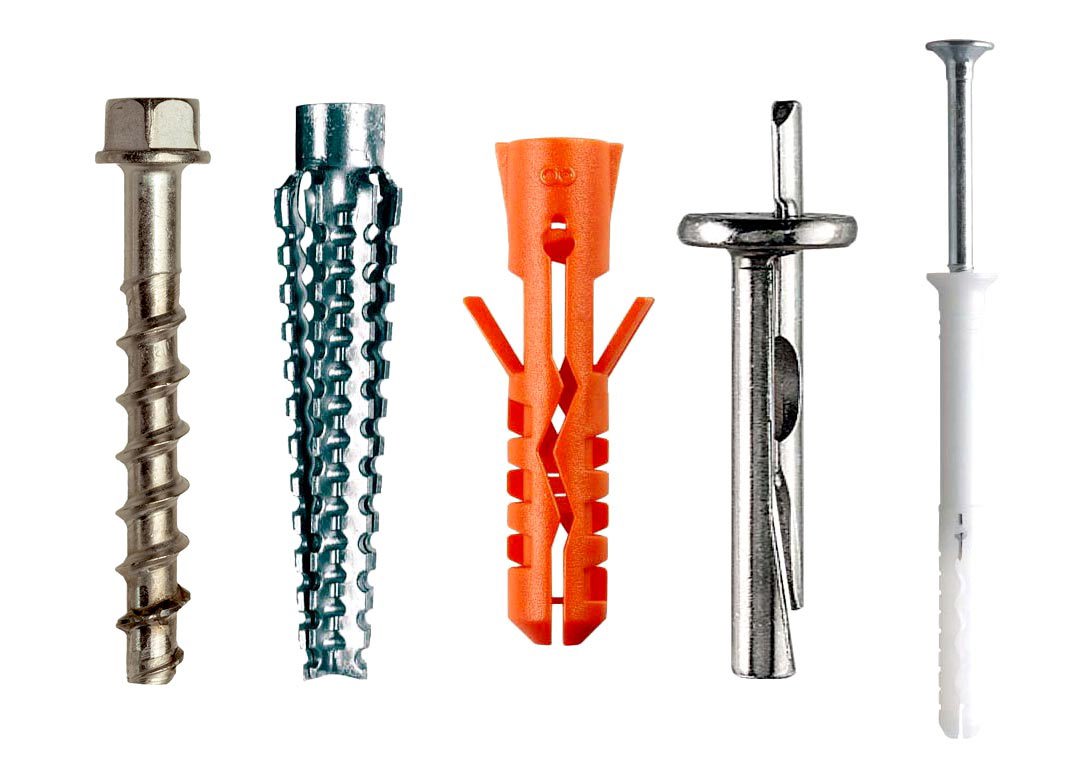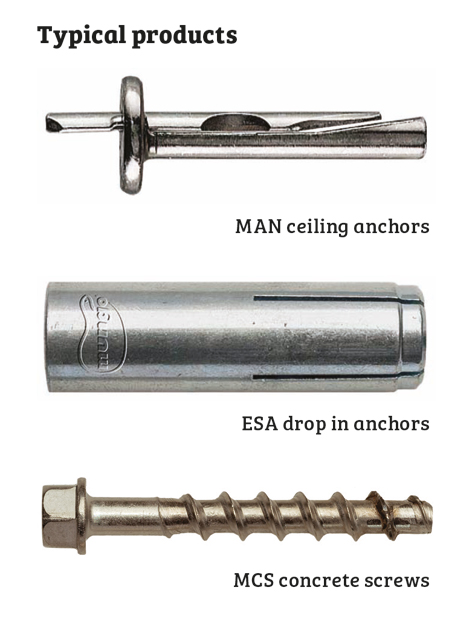The Vital Overview to Understanding Different Types of Anchoring Systems
Comprehending securing systems is essential for different applications, from marine to building and construction settings - Lightweight Anchoring Systems. Different supports offer unique objectives based on their atmosphere and tons requirements. This guide checks out the numerous kinds of supports, consisting of structure, watercraft, and ground supports. It additionally deals with the products used and key factors to consider for option. Each choice impacts stability and reliability. Exactly what should one focus on when picking the ideal support? The solution lies in advance
Types of Watercraft Anchors
When choosing a watercraft support, understanding the numerous types readily available is important for guaranteeing security and security on the water. The most typical kinds include the fluke support, understood for its lightweight layout and efficient hold in sand and mud; the plow support, which masters a selection of seabed conditions due to its self-setting capability; and the mushroom anchor, preferred for its holding power in soft bottoms. Another alternative is the grapnel support, usually utilized for tiny boats and kayaks, suitable for rough shallows. Each support type has specific applications, adding to its performance based upon the vessel dimension and ecological problems. Selecting the right anchor not only boosts safety however likewise boosts the overall boating experience. Recognizing these differences permits sailors to make educated choices, guaranteeing they maintain control and safety while traversing varied water bodies.
Structure and Structural Supports
Structure and structural anchors play an essential function in making certain the security and safety of numerous constructions - Site Security Anchors. These supports are vital components that protect frameworks to their foundations or assistance systems, stopping motion because of environmental aspects such as wind, seismic task, or soil settlement. Usual kinds include mechanical anchors, sticky anchors, and expansion anchors, each offering details objectives based on lots requirements and product compatibility
Mechanical anchors, for example, are usually utilized in concrete and stonework, offering high tensile strength. Glue anchors utilize chemical bonding to achieve robust connections, while growth supports are created to hold the surrounding material as they are tightened.
The choice of an ideal anchor type depends on variables such as load capacity, environmental problems, and the materials involved. Appropriate installation and upkeep of these supports are essential for the durability and safety of the framework, highlighting their value in building and construction and design techniques.
Ground Supports for Outdoor Structures
Ground anchors play a necessary function in safeguarding outdoor structures against ecological pressures. Numerous kinds of ground supports, together with their installment strategies, determine their efficiency and dependability. Additionally, factors to consider concerning lots ability are vital for ensuring the structural honesty of these setups.
Kinds of Ground Supports
Anchors work as the backbone for securing outdoor structures, ensuring security and safety and security in varying ecological conditions. There are a number of sorts of ground anchors, each created for particular applications and soil problems. Helical anchors include a screw-like layout, permitting easy installment in different terrains. Driven anchors are pounded right into the ground, providing solid resistance versus lateral lots. Grouted anchors use a bonding product to boost security, making them suitable for hefty structures. Deadman supports include a hidden mass that distributes lots, suitable for retaining walls and fences. Each kind serves a special purpose, allowing engineers and builders to pick the most reliable securing system based upon job demands and website conditions.
Installment Methods Review
Efficient installment strategies are vital for assuring the efficiency and longevity of ground anchors in exterior structures. Appropriate site evaluation comes before installation, where dirt conditions and dampness levels are assessed to figure out suitability. The choice of the appropriate support type need to line up with environmental aspects and structural requirements. During installment, precision is key; supports need to be positioned at the correct depth and angle to maximize their load-bearing capacities. Using the right tools, such as augers or hydraulic equipment, promotes accurate placement and reduces disruption to surrounding dirt. Following manufacturer guidelines for installation procedures is critical to accomplishing peak support efficiency. Lastly, post-installation evaluations assure that anchors are safely in position and functioning as planned, consequently enhancing the stability of the framework.
Load Ability Factors To Consider
When examining lots ability for ground anchors in outdoor frameworks, numerous important factors must be thought about to verify safety and security and efficiency. The soil kind plays a considerable duty; cohesive dirts provide various holding abilities compared to granular dirts. Additionally, the anchor's layout and material influence its toughness and longevity. Ecological conditions, such as wetness and temperature level changes, can also influence the support's performance with time. The intended lots, consisting of vibrant and static forces, need to be examined to verify the anchor can hold up against anxieties effectively. In addition, neighborhood guidelines and safety requirements have to be followed throughout the choice and installment process. Correctly examining these factors validates that ground anchors work dependably and support exterior structures securely.
Specialized Anchoring Systems
Specialty securing systems are made to meet special requirements in numerous applications, giving options where conventional anchors may fall short. These systems accommodate specific difficulties, such as those run into in undersea building and construction, high-altitude setups, or areas with unstable soil problems. Helical anchors are frequently used in aquatic settings due to their capacity to give strong holding power in soft sediment. Similarly, rock anchors are made use of in mountainous areas for protecting frameworks against rockfall or landslides. Specialty systems may likewise include chemical anchors, which bond with substratums to enhance load-bearing capacity. Additionally, they usually include sophisticated design techniques to attend to environmental elements, guaranteeing safety and security and stability in diverse problems. By utilizing customized designs, specialized anchoring systems use services that boost the sturdiness and performance of frameworks popular circumstances, making them essential in modern-day construction and design tasks.
Materials Made Use Of in Anchoring Solutions
The performance of securing systems is significantly influenced by the products utilized in their building and construction. Usual products include steel, aluminum, and numerous artificial composites, each offering distinctive benefits. Steel, frequently used for its stamina and longevity, offers durable support in tough atmospheres yet is vulnerable to corrosion if not correctly treated. Light weight aluminum, lighter than steel, offers resistance to deterioration and is excellent for aquatic applications, although it might not sustain heavy loads as effectively. Synthetic materials, such as nylon and polypropylene, are progressively preferred due to their light-weight residential or commercial properties and resistance to ecological elements. These products can additionally absorb shock lots, enhancing general efficiency. The selection of product plays an important duty in the efficiency and long life of anchoring systems, affecting their viability for specific applications. Recognizing these products allows for better decision-making in the layout and selection of securing solutions.
Aspects to Think About When Selecting an Anchor
Selecting an anchor needs cautious consideration of several essential variables that can substantially influence its efficiency and suitability for specific applications. The first aspect is the type of dirt or substrate, as different anchors execute much better in varying conditions such as sand, clay, or rock. In addition, the anticipated tons, including dynamic and static forces, must be assessed to determine the anchor's strength needs.
The support's size and weight are likewise significant, as they should match the vessel or framework being protected to ensure stability. Ecological problems, such as tidal activities and climate patterns, Full Report can even more affect support option.
The intended usage-- whether for long-term or short-term applications-- will affect the choice of support kind. Compatibility with various other anchoring systems can improve overall security and effectiveness. Subsequently, a comprehensive evaluation of these variables assures the ideal support is selected for peak performance.
Setup and Upkeep Tips

Routine assessments are necessary to recognize wear, deterioration, or any indicators of failure. Individuals ought to look for loose parts and tighten up or change them as required. Cleaning the support points periodically can stop the accumulation of particles that may jeopardize their integrity.
On top of that, customers must think about environmental elements such as wetness and temperature, which may affect the anchors' performance. Maintaining records of maintenance tasks can aid track the system's condition with time. Following these methods will boost the dependability and durability of securing systems, eventually contributing to the safety of the total structure.
Regularly Asked Inquiries
What Are the Environmental Impacts of Various Anchoring Systems?
The ecological influences of different securing systems consist of damages to aquatic ecosystems, sediment disruption, and possible injury browse around these guys to regional wild animals. Lasting techniques can minimize these effects, advertising much healthier undersea habitats and preserving biodiversity in seaside locations.
How Do Regulations Influence Anchoring System Choices?
Laws considerably influence securing system options by enforcing security requirements, environmental managements, and functional guidelines (Affordable Ground Anchors). Consequently, customers must follow these requirements, leading to the choice of systems that balance functionality, validity, and environmental considerations
Can I Use Multiple Supports Together?
Utilizing multiple supports together is possible and usually boosts stability. However, one have to take into consideration the certain conditions and features of each anchor kind, ensuring they function harmoniously to attain the preferred holding power and security.
What Prevail Mistakes When Using Anchoring Systems?
Usual errors when utilizing anchoring systems consist of inappropriate weight circulation, poor knowledge of environmental problems, disregarding regular devices upkeep, failing to represent tidal adjustments, and utilizing inappropriate materials, which can compromise safety and security and efficiency.
Exactly How Do Climate Condition Influence Support Efficiency?
Climate conditions considerably affect support performance, as solid winds and stormy waters can enhance pressure on the support. Additionally, heavy rain might change seabed problems, impacting the anchor's hold and overall security throughout damaging weather condition occasions.
